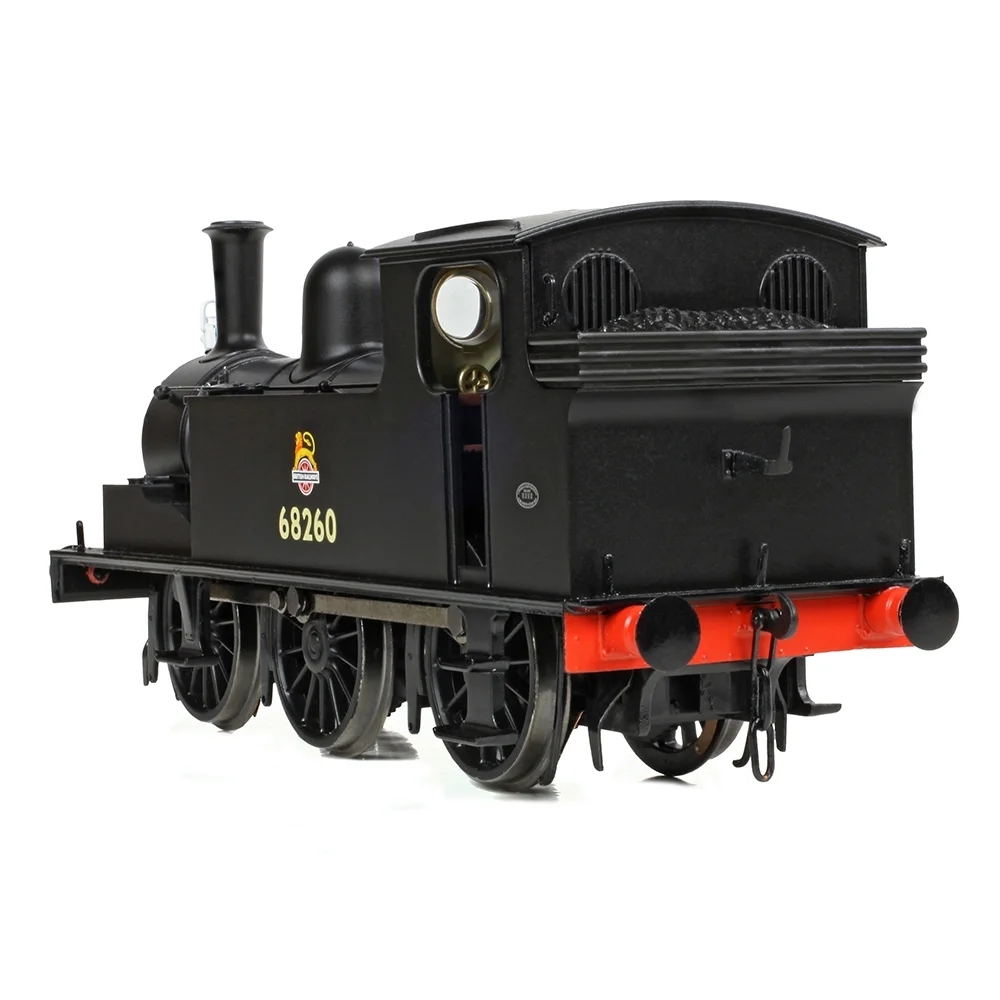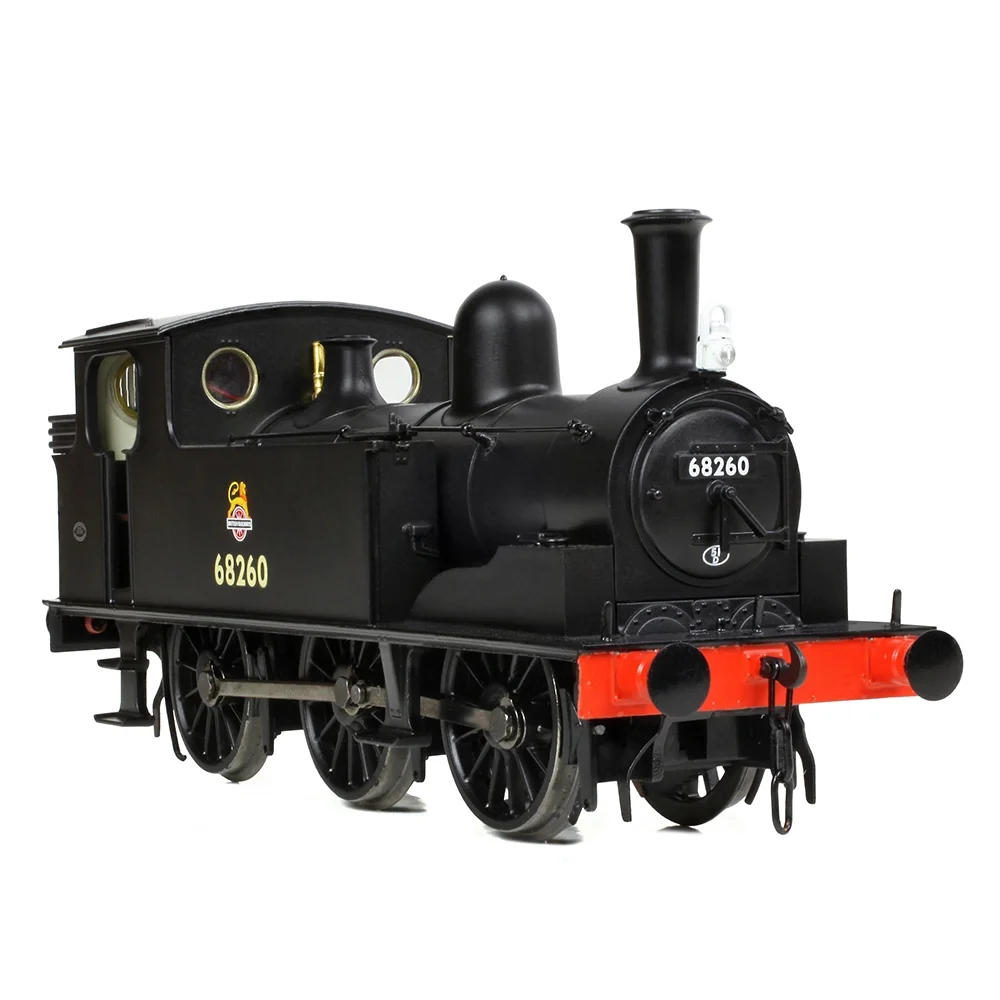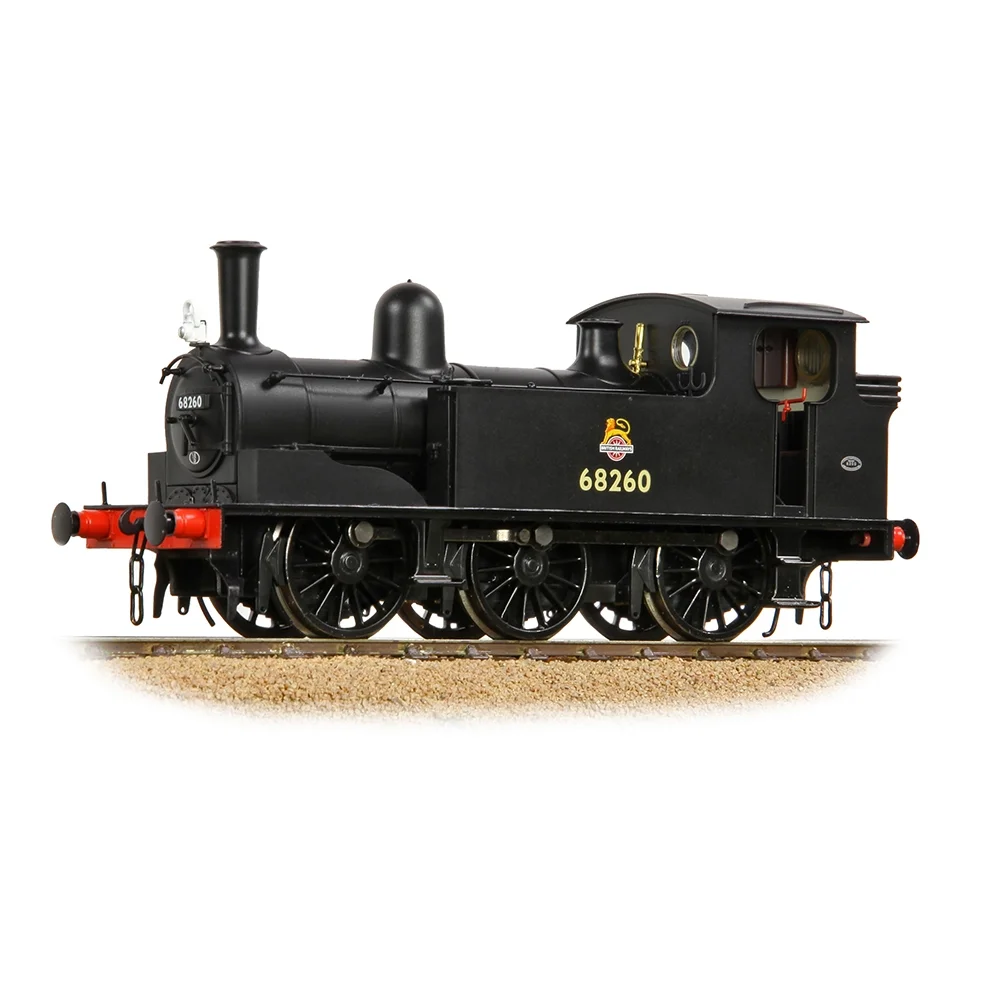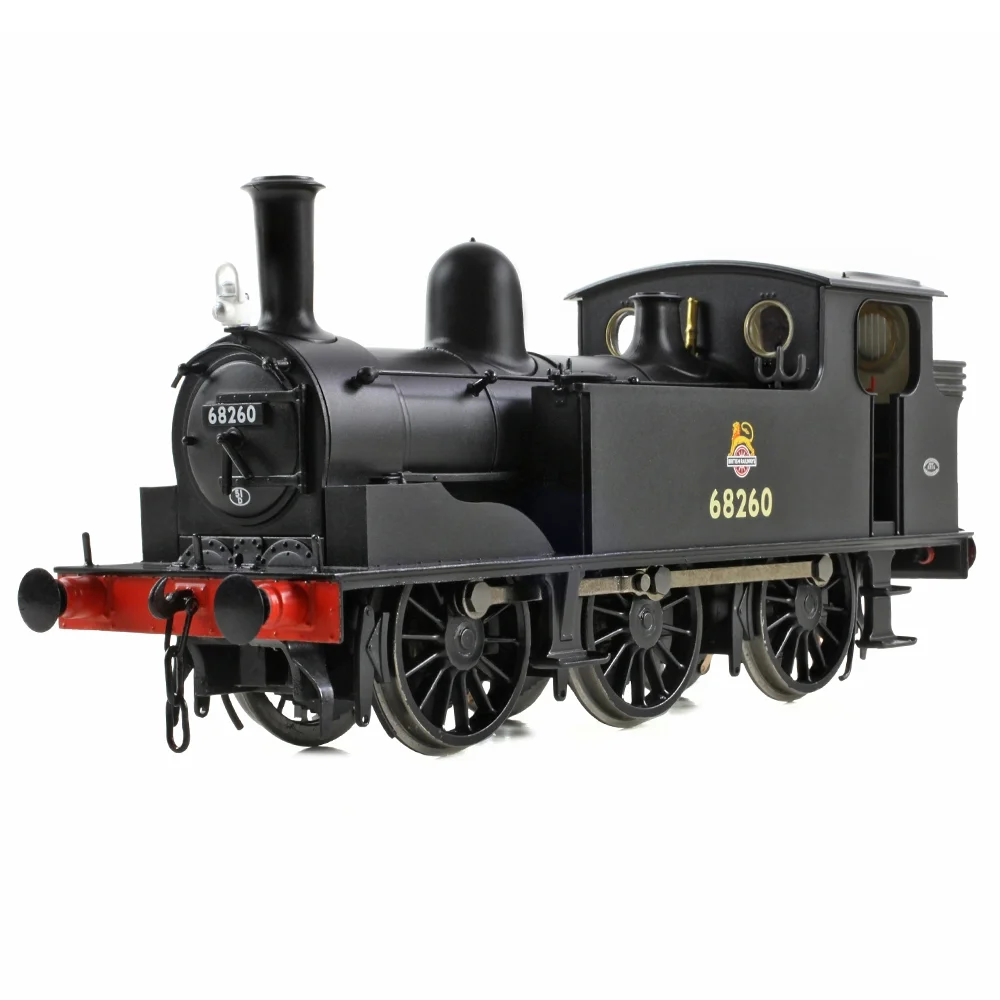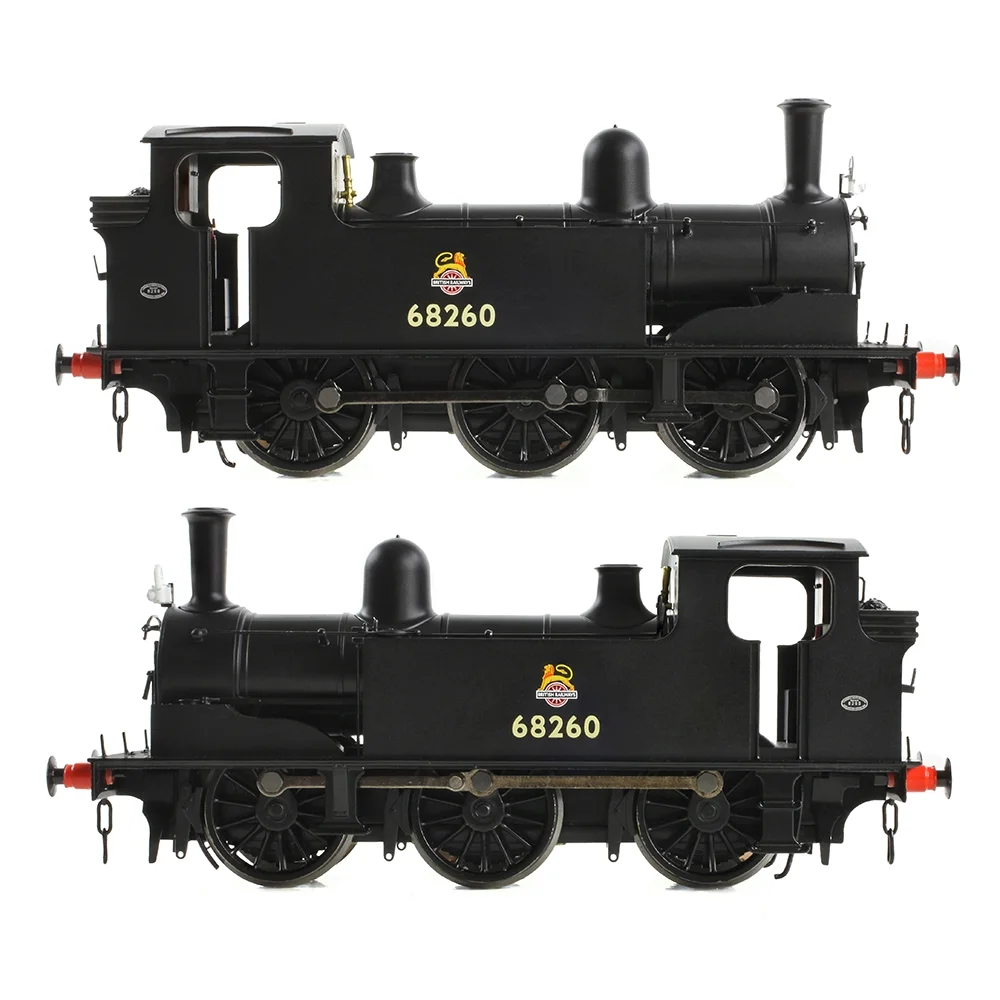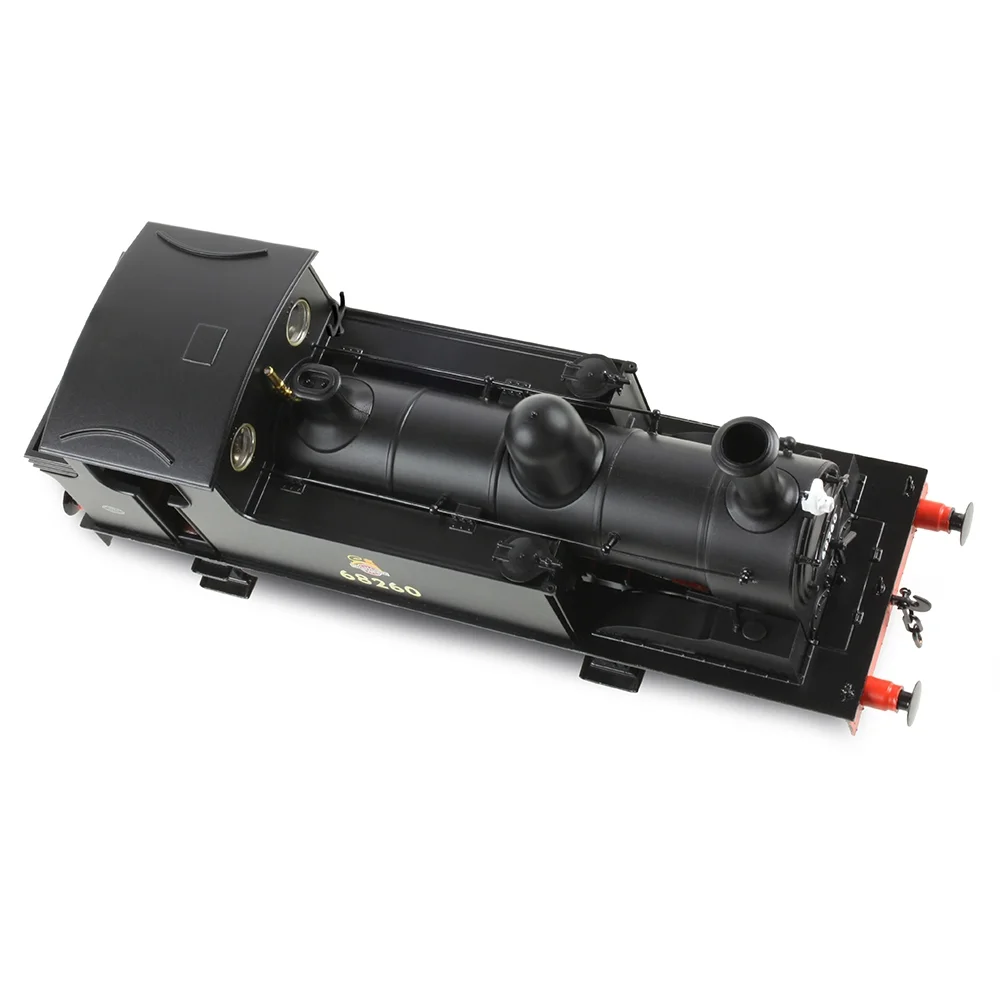Bachmann 31-069
London & North Eastern Railway J71 68260 British Railways Black with Early Emblem
Bachmann's Description & Specifications
The North Eastern Railway E Class 0-6-0T, later the LNER J71, was the forerunner to the E1 (LNER J72) and whilst models of the E1 have famously been made by Bachmann and its predecessor Mainline Railways for almost 50 years, the NER E Class has never been produced in OO Scale, until now!
Drawing inspiration from the all-new Branchline E1 model that was launched to great acclaim just a few years ago, the new E Class employs a wealth of new tooling to accurately depict the NER’s original standard 0-6-0 tank locomotive. Despite the similarities, the E Class is instantly recognisable thanks to its larger driving wheels, while the smaller bunker means that the tanks, cab and bunker on this Branchline model are all-new too. Then there is the original boiler with clack valves and Ramsbottom safety valves – another early feature that necessitates its own, dedicated tooling.
The model boasts a diecast metal running plate with integral tank weights, again produced new for the E Class to portray the differences seen between the E and E1, and to this the precision moulded components are added, from the tanks to the boiler and many smaller details alongside. Metal parts are then used to replicate features like the lamp irons, guard irons and sand pipes, and the handrails are made from metal wire which is fitted into turned metal knobs.
Inside, the Branchline E Class employs a coreless motor with diecast gearbox and the driving axles each have separate metal bearings, a combination that ensures smooth and reliable running. With electrical pickup from all wheels, a firebox lighting system and Next18 DCC interface, plus a pre-fitted speaker in every model, the E Class boasts the same impressive technical specification as its E1 relative. Whilst the drive train and electronics may not be visible, every part of the model that can be seen is treated to an exquisite paint finish to complete the look, with rich colours and precision printing of the numbering and lettering to produce a model as elegant as its Victorian prototype.
- Bachmann Branchline OO Scale
- Era 4
- Pristine BR Black Early Emblem Livery
- Running No. 68260
- Equipped with a Next18 DCC Decoder Socket – Recommend Decoder item No. 36-567A
- Length 118mm (over couplings)
Model Selection Rationale: Bachmann chose BR 68260 to represent the final phase of Class E operation, showing how these Victorian designs adapted to 1950s railway operations. The BR black livery with early British Railways branding captures the austere but dignified appearance of these locomotives in their twilight years, appealing to modelers interested in the transition period from steam to diesel traction.
DETAIL VARIATIONS SPECIFIC TO THIS MODEL
- Boiler Clack Valves Removed
- Ross Pop Safety Valves with Cover
- Pipe Whistle
- Steam Brakes Only
- Smokebox Door with Numberplate
- Twin Smokebox Door Handles
- Group Standard Buffers with Square Mounts
- Coal Bunker with Coal Rails fitted
- Rear Cab Windows with Bars fitted
This locomotive represents the "end of an era" variant in Bachmann's trilogy, showing how the Victorian Class E design looked in its final years of service.
MECHANISM:
- Coreless motor
- Electrical pickup from all wheels
- Separate metal bearings fitted to each driving axle
- Diecast metal chassis block
- Diecast metal gearbox, with gearing arranged for prototypical running speeds and haulage capabilities
- 5mm (OO gauge) wheels to NEM310 & NEM311 standards with authentic profile and detailing
- Detachable coupling pockets to NEM362 standards fitted at each end
- Designed to operate on curves of second radius (438mm) or greater
DETAILING:
- Diecast metal running plate with integral side tank weights
- Precision moulded plastic boiler, side tanks, cab and bunker
- Separately applied details including splashers, tank filler hatches, safety valves, dome and chimney, smokebox handles, clack valves* and vacuum pipes* (*where applicable)
- Individual metal detail components including handrails, handrail knobs, guard irons, lamp irons and turned metal whistle
- Highly detailed and decorated cab interior including controls, dials, gauges and tool cabinets with separately fitted regulator, reverser and handbrake
- Running gear detailing includes springs, brakes and separately fitted brake gear, sandboxes and sandpipes
- Glazed cab spectacles
- Sprung metal buffers
- Each model supplied with an accessory pack including cab doors, additional bufferbeam pipework, poseable lamps and three-link couplings
LIGHTING:
- Firebox Glow (on analogue) / Firebox Glow & Flicker (on DCC or when SOUND FITTED models are used on analogue)
DCC:
- Next18 DCC decoder interface
SOUND:
- Speaker installed in all models for optimum sound reproduction
- ESU Loksound Micro V5DCC Sound Decoder fitted to SOUND FITTED versions
- Sound files produced specifically for the Bachmann Branchline J71 using recordings from real locomotives
- SOUND FITTED models operate on DCC and Analogue control as supplied
LIVERY APPLICATION:
- Authentic liveries applied to all models
- Multiple paint applications employed on each model
- Logos, numerals and text added as appropriate using multi-stage tampo printing incorporating authentic typefaces, logos and colours
Class & Prototype
- Class: London & North Eastern Railway J71
- Traction: Steam
- Built: 1886-1895
- Total Built: 120
The North Eastern Railway Class E was T.W. Worsdell's highly successful 0-6-0T shunting locomotive, introduced in 1886 to replace aging Fletcher saddle tanks. With 120 built at Darlington Works between 1886-1895, these compact side-tank engines became the backbone of NER freight operations from Durham coalfields to Tyne docks.
Featuring 4ft 7¼in driving wheels, 16in × 22in inside cylinders, and 140 psi boiler pressure, the Class E prioritized reliability over complexity with simple Stephenson valve gear. The design proved exceptionally durable - the last example served 74 years until 1961, making it one of Britain's longest-serving locomotive classes.
Under the LNER they became Class J71, with 81 surviving to British Railways as numbers 68230-68316. Their robust design directly inspired the famous J72 class, creating a locomotive lineage spanning 1886-1951.
- Running Number: 68260
- Name: -
- Ordered By: North Eastern Railway
- Built By: North Eastern Railway
- Built At: Darlington
- Built: 07/1890
- Withdrawn: 03/1960
- Length of Service: 69.7 years
- Running Numbers: NER 400, LNER 8260, BR 68260
- Names: -
Built in July 1890 at Darlington Works during the middle production period, NER No. 400 represents the typical career path of a Class E locomotive that survived through all three major railway administrations. Originally numbered 400 under the North Eastern Railway, it was renumbered to LNER 8260 during the 1946 renumbering scheme and became BR 68260 upon nationalization in 1948.
This locomotive exemplifies the remarkable longevity that made the Class E design so successful, serving for 69.7 years before withdrawal in March 1960. Its survival through to the final years of steam operation meant it witnessed the complete transformation of British railways from Victorian industrial expansion through two world wars to the dawn of the diesel age.
As one of the 81 Class E locomotives that survived into British Railways ownership, No. 68260 would have spent its final years in the standard BR black livery that characterized the railway's austere post-war image. During this period, these veteran locomotives were increasingly relegated to light shunting duties as more modern diesel shunters began replacing steam for such work.
No. 68260 carried the standard Class E specification with 4ft 7¼in driving wheels and 16in × 22in cylinders, representing the proven design that T.W. Worsdell established in the 1880s. Its three number changes (NER 400 ? LNER 8260 ? BR 68260) tell the story of British railway consolidation and nationalization in microcosm.
Historical Context: This locomotive's 1960 withdrawal came just one year before the class extinction with BR 68233 in 1961, making it one of the very last examples of T.W. Worsdell's 1886 design in active service.
Operator & Livery
- Operator: British Railways
- Livery: Black with Early Emblem
British Railways transformed Britain's fragmented rail network into a unified national system following nationalisation on 1st January 1948. Created from the "Big Four" companies under the Transport Act 1947, BR operated most of Great Britain's railways until rebranding as British Rail in 1965, managing over 20,000 route miles and inheriting nearly 20,000 locomotives of diverse designs.
The organisation pioneered standardisation through its revolutionary BR Standard locomotive programme (1951-1960), producing 999 advanced steam engines under Robert Riddles' direction. These included the versatile Britannia Pacifics, mighty 9F freight engines, and mixed-traffic classes that incorporated the best features from all predecessor companies. The 1955 Modernisation Plan accelerated diesel and electric traction development, creating fascinating mixed-traction operations.
Notable achievements included establishing unified locomotive classification systems, introducing distinctive corporate liveries, and managing the complex transition from steam to modern traction. BR's six regional structure preserved operational diversity whilst enabling standardisation of practices, signalling, and rolling stock that had eluded private enterprise for over a century.
The BR era represents steam traction's final flowering alongside emerging diesel technology, creating unparalleled locomotive variety. Today, this heritage remains highly popular with railway enthusiasts through extensive preserved fleets, heritage railway operations, and comprehensive model ranges from manufacturers like Hornby, Bachmann, and Dapol, making BR subjects essential for authentic post-war British railway modelling across all scales.
British Railways' plain black livery was designated specifically for freight and shunting locomotives from 1948, representing the most economical and practical finish for inherently dirty industrial machines. During the early nationalisation period, many locomotives were simply patch-painted over old company markings with black paint, which quickly weathered to match the existing finish as these engines were rarely cleaned. The "Lion and Wheel" emblem (nicknamed the "Cycling Lion") was introduced from December 1948 and applied to plain black locomotives from early 1949, featuring a lion standing over a large railway wheel with "British Railways" lettering across the centre.
The emblem was produced in three sizes and always faced forward, positioned centrally on tender sides or tank sides, with regional preferences evident—the Western Region favoured larger emblems whilst other regions used smaller versions. Plain black locomotives retained red buffer beams and received white "BRITISH RAILWAYS" lettering in Gill Sans style before the emblem's introduction. Some former company locomotives, particularly ex-GWR shunting engines, retained their original lettering well into the early 1960s as they didn't require renumbering and received minimal attention. This utilitarian livery remained standard for freight operations until the mid-1950s emblem change, making it essential for authentic early BR period modelling of goods yards, collieries, and industrial operations.
